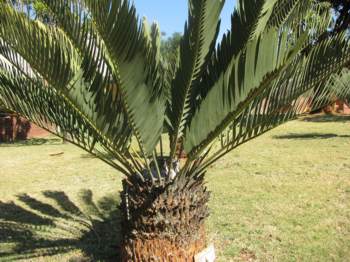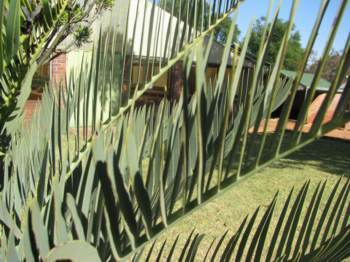Encephalartos eugene-maraisii
Encephalartos eugene-maraisii I.Verd.
Family: Zamiaceae
Common names: Waterberg cycad (Eng.); bergpalm, waterberg-broodboom (Afr.); mofaka (Sepedi)
SA Tree No: 3.1
Introduction
This is a medium-sized to large, bluish-green cycad, which is suited to cool subtropical and temperate regions.

Description
Description
Encephalartos eugene-maraisii has a medium-sized to large cycad with an erect, aerial stem that sometimes becomes procumbent with age. The stem can usually grow up to about 4m long and 0.45 m in diameter with soft whitish cataphylls at the crown of the stem.

Leaves are rigid, up to 0.7-1.5 m long, light bluish green, and slightly curved downwards with the leaf tip usually curved slightly upwards. Median leaflets are about 150-200mm long and 13-18 mm in diameter. Leaflets are leathery and without nodules. Leaflet margins are not thickened and entire except for the occasional single tooth on the lower margin. Basal leaflets decrease in size to one or two spines at most.

Male and female plants produce cones in December which are reddish-brown due to a dense layer of hairs which covers the greenish-grey underlying part of the cone. Male plants bear 1-8 cones per season per stem. They are 200-450 mm long and 60-100mm long in diameter. They often emit a strong odour during pollen shedding which normally takes place from February to March. Female plants bear 1-6 cones per season per stem. They are 300-500mm long and 160-200mm in diameter. The female cones of Encephalartos eugene-maraisii do not disintegrate spontaneously, but dry out from May to August. They produce seeds which are light brown, 35-44mm long and 23-30mm in diameter.
Encephalartos eugene-maraisii is closely related to several other species ( E. middelburgensis, E. dyerianus, E. dolomiticus and E. hirsutus ), but it is distinguished from the others by its straight leaves that recurve at their ends, spineless median leaflets, clear petiole, and green cones with a fine brown wool.
Conservation Status
Status
According to Red List of South African Plants, Encephalartos eugene-maraisii is assessed as Endangered (EN), as the best available evidence indicates that it meets all five IUCN criteria for Endangered, and is therefore facing a very high risk of extinction in the wild.
Distribution and habitat
Distribution description
This species is endemic to South Africa where it grows in the Waterberg and adjacent areas among low shrubs on rocky hills and steep slopes in open grassland and savanna. The Waterberg climate is hot in summer and very cold in winter. In their distribution area the annual rainfall is 600 to 750mm and falls predominantly in summer. This species is a relatively slow grower, very frost resistant and does best in full sunlight.
Derivation of name and historical aspects
History
The name Encephalartos is derived from the Greek en meaning 'within', kephali meaning 'head', and artos meaning 'bread'. Inez Clare Verdoorn described this species in 1945. The epithet is in honour of her uncle, Eugene Nielen Marais, the celebrated author, poet and naturalist, who brought the species to the attention of the scientific community.
Ecology
Ecology
Cycads use smells and heat to attract and repel insect pollinators. The plants heat up and produce a strong odour that drives the pollen-covered insects out of the cones of male cycads. The female cones then attract these same insects with a milder, more alluring odour. When the insects move between the sexes, they inadvertently transfer the pollen from the male cones to the receptive ovules of the female cones.
The fleshy outer covering layer of the seeds is desirable food for a range of animals such as monkeys, birds, rodents and bats. Therefore, with some luck, the seeds are discarded some distance away from the parent plant in a hospitable environment in which they are likely to germinate.
Uses
Use
Cycads can be used as decorative or focal point plants in gardens and can also be very effective as grouped plantings. In ancient times, people used to make bread out of the stem by scraping out the pith, burying it in the earth, and leaving it for about two months to rot. After two months it would be unearthed, kneaded, and made it into a bread for people to eat.

Growing Encephalartos eugene-maraisii
Grow
Encephalartos eugene-maraisii grows relatively slowly and does well in full sun. It is a very frost-hardy species. It is easily propagated from seeds and suckers (the young plants that grow around the main stem).
The seeds are collected, cleaned and stored in a brown paper bag at 10-15°C for six months or more, to allow the embryo to fully develop. The seeds are cleaned to ensure that all the flesh is removed, since it may contain germination inhibitors and can also promote the growth of fungi. The flesh is scraped away with a knife but protective gloves should be worn during the cleaning operation to prevent contact with the slow-acting poisons present in the flesh. If the flesh is hard and dry, it helps to soak the seeds in water for a day or two before cleaning. Even if the seeds have been cleaned, it is a good idea to soak them for a few days, preferably with daily changes of water, before planting them. When the seeds are placed in water, the viable ones will sink and the non-viable ones will float.
To germinate the seeds, place the cleaned seeds on their sides half buried on washed sand or potting mix, and keep at about 28°C. It is necessary to keep the medium moist, but not too wet, for as long as it takes for germination to take place. As soon as the radicals of the sprouted kernels are 10-20mm long, they can be planted singly in bags containing potting soil or some other suitable medium. Alternatively one can wait until the seedlings develop one or two leaves before transplanting them individually into bags.
Because cycad seedlings form long taproots, it is advisable to use tall narrow perforated black plastic bags about 240×120mm in size for their initial establishment. Place the seedlings under shade for the first few years of growth and development. Initially the seedlings must be watered daily with a fine spray. After about a month, as their roots elongate, the frequency of watering should be decreased to once a week. The seedlings can be transplanted into the garden when they are 3-5years old. When preparing to propagate from suckers, a hole should be dug around the stem of the mother plant to expose the base and roots of the suckers. One must use a clean sharp knife or sharp spade to remove the sucker from the mother plant. The wound should then be treated with a fungicide and dried for about a week before planting the sucker into a sterile medium.
Cycads are ideal for a low-maintenance garden, as they require a minimum of water and are undemanding in their soil and environmental needs.
Troublesome pests include scale insects, beetles and chewing insects. Scale insects cause great damage to cycad leaves by sucking the sap from them. Most scale insects can be controlled with regular and frequent applications of horticultural soluble oil such as white oil. Beetles seriously damage cycad plants by attacking the emerging young leaves. Control can be kept by application of contact or systemic insecticides, or one of the bacterial preparations available.
References
- Barkhuizen, B.P. 1975. The cycad garden of UNISA . UNISA Press, Pretoria.
- Giddy, C. 1974. Cycads of South Africa . Struik, Cape Town.
- Grobbelaar, N. 2002. Cycads of Southern Africa . Published by author, Pretoria.
- Jones, D.L. 1993. Cycads of the world: Ancient plants in today's landscape . Reed, New South Wales.
- Raimondo, D., Von Staden, L., Foden, W., Victor, J.E., Helme, N.A., Turner, R.C., Kamundi, D.A. & Manyama, P.A. (eds). 2009. Red List of South African plants 2009. Strelitzia 25. South African National Biodiversity Institute, Pretoria.
Credits
K.W. Sepheka
National Herbarium, Pretoria
July 2014
Plant Attributes:
Plant Type: Shrub, Tree
SA Distribution: Limpopo
Soil type: Sandy, Loam
Flowering season:
PH: Acid, Neutral
Flower colour:
Aspect: Full Sun
Gardening skill:
Special Features:
Horticultural zones











Rate this article
Article well written and informative
Rate this plant
Is this an interesting plant?
Login to add your Comment
Back to topNot registered yet? Click here to register.